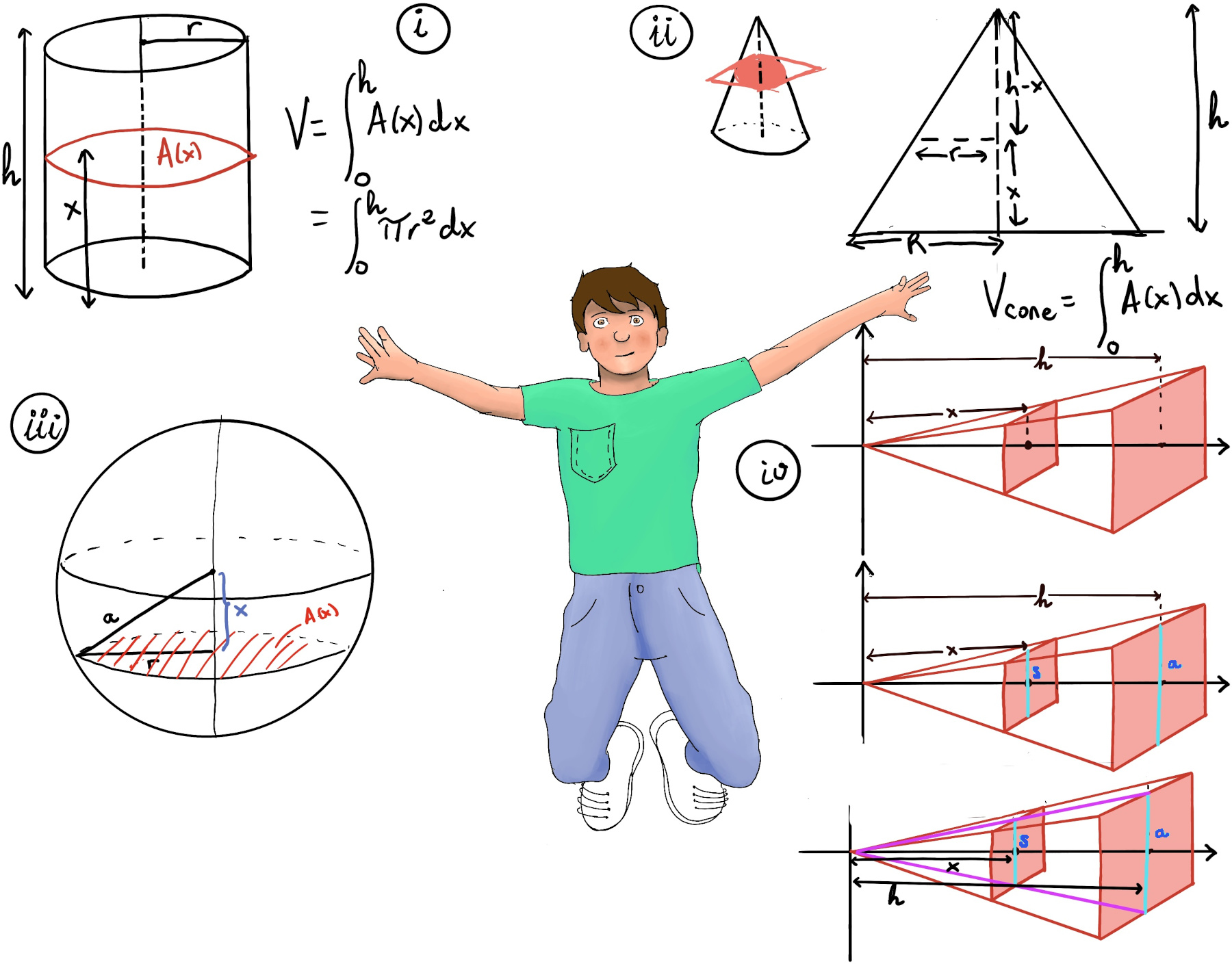
|
 |
 |

|
 |
 |
Of course I’m in shape. Round is a shape.
Antiderivatives are fundamental concepts in calculus. They are the inverse operation of derivatives.
Given a function f(x), an antiderivative, also known as indefinite integral, F, is the function that can be differentiated to obtain the original function, that is, F’ = f, e.g., 3x2 -1 is the antiderivative of x3 -x +7 because $\frac{d}{dx} (x^3-x+7) = 3x^2 -1$. Symbolically, we write F(x) = $\int f(x)dx$.
The process of finding antiderivatives is called integration.
The Fundamental Theorem of Calculus states roughly that the integral of a function f over an interval is equal to the change of any antiderivate F (F'(x) = f(x)) between the ends of the interval, i.e., $\int_{a}^{b} f(x)dx = F(b)-F(a)=F(x) \bigg|_{a}^{b}$
Calculating volumes with integrals is tricky and involves a variety of techniques such as slicing, the shell method, and the washer method.

This is quite simple, A =[Each cross section is a semicircle] $\frac{1}{2}πr^2 =$ [d = 2sin(x) ⇒ r = sin(x)] $\frac{1}{2}π(sin^2x)$.
V = $\int_{0}^{π} \frac{1}{2}π(sin^2x)dx = \frac{1}{2}π\int_{0}^{π}(sin^2x) =\frac{1}{2}π\int_{0}^{π}\frac{1}{2}(1-cos(2x))dx = \frac{1}{4}π·(\int_{0}^{π} dx - \int_{0}^{π} cos(2x)dx) = \frac{1}{4}π·(x -\frac{1}{2}sin(2x))\bigg|_{0}^{π} = \frac{1}{4}π(π-\frac{1}{2})sin(2π)-(0-\frac{1}{2}sin(0)) = \frac{1}{4}π^2 ≈ 2.467 cm^3$

The area of an equilateral triangle can be calculated using the formula: A(x) = $\frac{\sqrt{3}}{4}s^2$ where A is the area and s is the length of one side of the equilateral triangle. Since $x^2+y^2=4 ⇒ y^2=4-x^2$ ⇒[First quadrant] $y = \sqrt{4-x^2} ⇒ S = 2\sqrt{4-x^2} ⇒ A(x) = \frac{\sqrt{3}}{4}4(4-x^2) = \sqrt{3}(4-x^2)$
V =[the circle x2 + y2 = 4 has a radius r = 2 and x ∈ [-2, 2]] $\int_{-2}^{2} \sqrt{3}(4-x^2)dx = \sqrt{3}(4x -\frac{1}{3}x^3)\bigg|_{-2}^{2} = \sqrt{3}(8 -\frac{1}{3}8-(-8-\frac{1}{3}(-8))) = \sqrt{3}(8 -\frac{1}{3}8+8+\frac{1}{3}(-8)) = \sqrt{3}(16-\frac{16}{3}) = \sqrt{3}(\frac{48}{3}-\frac{16}{3}) = \frac{32·\sqrt{3}}{3}$

The volume of a solid that extends from y = a to y = b and has a known integrable cross-sectional area A(y) perpendicular to the x-axis is given by the formula for the general slicing method, that is, V = $\int_{a}^{b} A(y)dx = \int_{0}^{2} A(y)dy$.
The equation of the line passing through two points (x1, y1) and (x2, y2) is $y -y_1 = \frac{y_2-y_1}{x_2-x_1}(x-x_1)$ ⇒ The line that crosses between (0, 2) and (2, 0) is $y-2=\frac{-2}{2}(x-0) ↭ y - 2 = -x$ ↭ y = 2 - x.
A(y) =[Formula for the area of a semicircle] $\frac{π}{2}r^2$ where r is the radius =[Since the diameter is 2-x, the radius of the semicircle is half that quantity, but we need it as a function of y. y = 2-x ↭ x = 2-y] $\frac{π}{2}*(\frac{2-y}{2})^2$
V = $\int_{0}^{2} A(y)dy = \int_{0}^{2} \frac{π}{2}*(\frac{2-y}{2})^2dy = \frac{π}{8} \int_{0}^{2} (4-4y+y^2)dy = \frac{π}{8}(4y+\frac{-4}{2}y^2+\frac{y^3}{3}) = \frac{π}{8}(4y-2y^2+\frac{y^3}{3}) = \bigg|_{0}^{2} = \frac{π}{8}(8-8+\frac{8}{3}) = \frac{π}{3}.$

A cone is a three-dimensional solid geometric shape having a circular base and a pointed edge at the top called the apex. A right circular cone is a cone where the axis of the cone is the line meeting the vertex to the midpoint of the circular base (Figure ii).

We are going to integrate along the height of the cone and choose x to be the vertical direction. The cross sections are simply circles, but the radius varies from the base of the cone to the apex.
By similarity of triangles, $\frac{r}{h-x} = \frac{R}{h} ⇒ r = \frac{R}{h}(h-x) ⇒ A(x) = π\frac{R^2}{h^2}(h-x)^2, V = \int_{0}^{h} π\frac{R^2}{h^2}(h-x)^2dx = π\frac{R^2}{h^2}\int_{0}^{h}(h-x)^2dx = $[By substitution of variables u = h -x, du = -dx, u1 =h, u2 = 0] $π\frac{R^2}{h^2}(-\int_{h}^{0}u^2du) = π\frac{R^2}{h^2}\frac{-u^3}{3}\bigg|_{h}^{0} = π\frac{R^2}{h^2}(-0+\frac{h^3}{3}) = \frac{π}{3}R^2h$

The solid of revolution is formed by revolving the region R around the x-axis ⇒ the cross-sections are circles, A(x) = πr2 where r = f(x)
V = $\int_{0}^{ln(4)} π(e^{-x})^2dx = \int_{0}^{ln(4)} π(e^{-2x})dx = π\frac{-1}{2}e^{-2x}\bigg|_{0}^{ln(4)} = \frac{-π}{2}(e^{-2ln(4)}-e^0) = \frac{-π}{2}(e^{ln(4)^{-2}}-1) = \frac{-π}{2}(\frac{1}{16}-1) = \frac{-π}{2}·\frac{-15}{16} = \frac{15π}{32}$

The solid of revolution is formed by revolving the region around the x-axis ⇒ the cross-sections are circles, A(x) = πr2 where r = f(x)
V = $\int_{0}^{\frac{1}{2}} π(\frac{1}{\sqrt[4]{1-x^2}})^2dx = π\int_{0}^{\frac{1}{2}} \frac{1}{\sqrt{1-x^2}}dx = π·sin^{-1}(x)\bigg|_{0}^{\frac{1}{2}} = π·(sin^{-1}(\frac{1}{2})-sin^{-1}(0)) = π(\frac{π}{6}-0) = \frac{π^2}{6}.$

The solid of revolution is formed by revolving the region around the x-axis ⇒ the cross-sections are circles, A(x) = πr2 where r = f(x) = x2-4x +5, and the volume is $\int_{1}^{4} πr^2dx = \int_{1}^{4} π(x^2-4x+5)^2dx = π\int_{1}^{4}(x^4-8x^3+26x^2-40x+25) = π(\frac{x^5}{5}-8\frac{x^4}{4}+26\frac{x^3}{3}-40\frac{x^2}{2}+25x) = π(\frac{x^5}{5}-2x^4+26\frac{x^3}{3}-20x^2+25x)\bigg|_{1}^{4} ≈ 49.009$
Let f be continuous and non-negative, let R be the region bounded above by the graph of x, below by the x-axis, on the left by x = a, and on the right by x = b. Then, the volume of the solid of revolution formed by revolving R around the x-axis is given by V = $\int_{a}^{b} πf(x)^2dx$